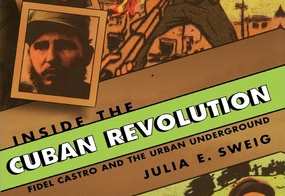
Inside the Cuban Revolution: Fidel Castro and the urban underground
Julia E Sweig, Harvard University Press 2002, £20.50
Julia Sweig’s book, the result of eight years of research with access to newly declassified documents, exposes the myth that the Cuban revolution was imposed by a dozen middle-class, bearded rebels in the mountains, and challenges three pieces of conventional wisdom: 1) that there was a rivalry between the rural Sierra wing of the revolutionary Movement of 26 July (M267), and the urban Llano wing, 2) that 1959 was the most important year of the Cuban revolution and 3) that the initiative for the disastrous general strike in April 1958 came from Fidel Castro, in order to destroy the Llano and take control of the M267.
Frank Pais was a militant who joined forces with Fidel Castro, Abel and Haydee Santamaria and others before the attack on Moncada barracks in July 1953. While Castro was incarcerated and throughout his period of exile and training in Mexico with the group who went on to constitute the core of the Rebel Army, Pais worked to build up the urban underground, with civilian and military cells throughout the island. As the Rebel Army mobilised in the Sierra mountains, Pais founded M267 cells to work as front-groups among workers and students and set up a civil resistance movement. Sweig’s new evidence shows that ‘the reorganization of the movement reflected both Pais’ autonomy from the Sierra and Fidel, and Fidel’s confidence in and dependence upon Pais’ (p43). Pais and the urban underground were vital for establishing a flow of weapons and recruits from the cities to the Rebel Army.
Like Castro, Pais believed that workers must be in the vanguard of the movement against the US-puppet dictator Batista, and he drove forward plans for a revolutionary general strike. ‘The general strike strategy that Pais outlined complemented Fidel’s guerrilla war in the Sierra. Indeed, his plan to restructure the National Directorate suggests a vision of the two strategies, urban insurrection and guerrilla warfare, as mutually reinforcing but tactically separate in terms of day-to-day operations.’ (p46)
Since the murder of communist workers 1947-1952, the trade union movement had been in the hands of the reactionary Eusebio Mujal, who collaborated with Batista. Before Pais’ workers’ fronts had built sufficient strength to challenge the gangster-run unions, he was murdered by the regime, on 30 July 1957, aged just 23. ‘Some sixty thousand Santigueros, from local Communist Party members to the leadership of the Santiago Civic Institutions, attended Pais’ funeral. Even the M267 underground emerged to grieve publicly, openly donning their black and red arm bands.’ (p48) Businesses closed and workers went on spontaneous strike for several days until government repression forced them to return.
‘Just one day before he was murdered, Pais had successfully orchestrated a province-wide fifteen-minute workplace shutdown organized by Civic Resistance labor cells, as a finale to several similar actions that had occurred throughout July.’ (p48) Sweig demonstrates the connection between the M267 and the working-class and civil society and shows that the initiative for the failed general strike of April 1958, came from the urban underground as the culmination of months of work within the labour movement.
Sweig explains the failure of the general strike, how it crippled the M267, which had 200 of its workers’ militants gunned down in Havana alone, and that it resulted in a change of revolutionary tactics. As the movement against Batista grew throughout 1957 and 1958, repression and brutality by the regime in the cities, where its repressive apparatus was concentrated, made revolutionary work far more dangerous and difficult for the urban M267 than life with the Rebel Army.
Sweig’s book also tracks the M267’s relationship with the student revolutionaries, communists and the bourgeoisie and how they dealt with the political machinations of the exile community. From summer 1958, the urban M267’s student front orchestrated a total school shutdown, and their united workers’ front, with communists and other groups, prepared for the revolutionary general strike. This came on the 2 January 1959, called by Fidel Castro, and enabled the Rebel Army to take control of Santiago without firing a shot, while Che Guevara and Camilo Cienfuegos’ guerrilla columns were welcomed into Havana by millions out celebrating on the streets.
This book is vital for anyone interested in understanding the Cuban revolution, and it destroys the arguments of those British Trotskyists who deny its working class character.
Helen Yaffe




